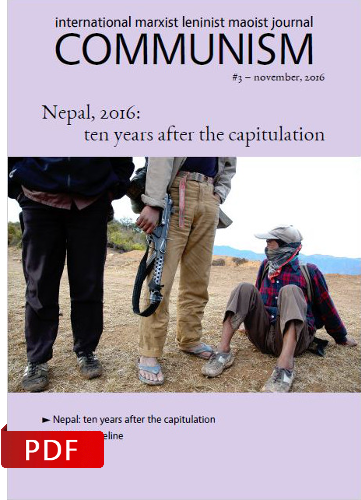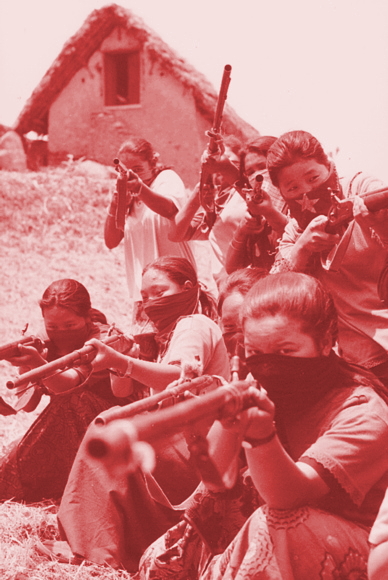OWA (MLM-pM), MLM Center (B), CPF(mlm) - Nepal: ten years after the capitulation
Submitted by Anonyme (non vérifié) Ten years ago, on November 21, 2006, the World Revolution knew a setback with the capitulation of the Communist Party of Nepal (Maoist), which ceased its People's War to accept a “comprehensive Peace Agreement” with the government.
Ten years ago, on November 21, 2006, the World Revolution knew a setback with the capitulation of the Communist Party of Nepal (Maoist), which ceased its People's War to accept a “comprehensive Peace Agreement” with the government.
At the time of the capitulation, the People's War in Nepal began indeed to be world known. It controlled up to 80 percent of the country, after ten years of armed struggle where the Revolution presented itself as strategic proposition for the entire masses. The People's Liberation Army, strong of 30, 000 combatants, went on from victory to victory.
Maoism, as leading ideology from the People's War, was in a process of spreading all over the world, with in the background the historical advances made by the Communist Party of Peru, whereas in India there was a strong reorganization which brought the founding of the Communist Party of India (Maoist).
The capitulation was a terrible betrayal from this situation in development. Deeply influenced by the eclectic tendencies of the Maoist current called Revolutionary Internationalist Movement, the Communist Party of Nepal (Maoist) fell into a pragmatic-machiavelic line.
This was strongly intensified by the decadent way of life of its leadership, corrupted by the imperialist lifestyle, what brought a spirit of acceptance of the social and democratic “improvement” by imperialism considered as a unified globalized system.
The idea of a general victory was abandoned, as it was thought that both India and China, and also the USA, would block any further development. The city of Kathmandu was not considered as possible to be taken; the army, on the contrary of the police, seemed supposedly unbreakable.
Therefore, the Communist Party of Nepal (Maoist) precipitated itself in the possibility of an alliance with the parliamentarian political parties which, in the situation of crisis where the Monarchy took all the control of the country, accepted to form a Republic, in exchange of the end of the People's War.
This was just a new laying out of the semi-feudal semi-colonial nature of the country, but the Communist Party of Nepal (Maoist), hoping for a quick integration, self-intoxicated itself, with the “people's revolt” as phantasmagoria.
In fact, the Communist Party of Nepal (Maoist) already imagined that it found a new method combining insurrection and people's war.
After the capitulation, it continued its idealist innovations with the revisionist theory of a multiparty constitution, where all political parties were considered as anti-feudal, because they were opposed to Monarchy, where therefore the destruction of the old state was conceived as not possible and even not necessary, as the general democratization, with the Communist Party of Nepal (Maoist) being the major force in the country, would be unavoidable.
This concept of “democratization” was not new: it was a mere renewal of the revisionist thesis of Karl Kautsky and Maurice Thorez in the imperialist countries.
More precisely, it is what was professed by all the revisionist currents in the third world during the 1960's-1990's period, pretending to make a front with the national bourgeoisie to reform the country, when there were in reality trying to build a new bureaucratic bourgeoisie serving Soviet Social-imperialism.
 Nowadays, as there is no Soviet Social-imperialism any more, such a tendency can only lead to the subordination to imperialists or expansionist semi-colonial powers. In Nepal, it is easy to see that Prachanda became the lackey of India.
Nowadays, as there is no Soviet Social-imperialism any more, such a tendency can only lead to the subordination to imperialists or expansionist semi-colonial powers. In Nepal, it is easy to see that Prachanda became the lackey of India.
And of course, as the Communist Party of Nepal (Maoist) became a part of the world system of exploitation and oppression, it was strongly supported in its capitulation.
Naturally, the electoral victory of the Communist Party of Nepal (Maoist) was greeted all over the world by all the revisionist forces. The calls to support the Nepal Revolution grew always more as soon as the peace agreement were signed. There were even groups appearing calling to support the People's War in Nepal, when it was already over.
Revisionists won prestige of this and the Communist Party of Nepal (Maoist) profited from this in keeping being considered as revolutionary.
But this was sadly not all. The vast majority of the forces upholding Maoism supported this process.
Instead of considering that the peace agreement was the end of the process transforming the Communist Party of Nepal (Maoist) in a revisionist party, it was considered that it was only the beginning of it.
Years after the peace agreement, it was still spoken of a “complicated” situation and it was explained that still everything was possible, that a “red line” was growing, a new party in constitution, etc.
Ten years after the peace agreement, we can see that this was fully erroneous. There was no such thing like a “red line” in the Communist Party of Nepal (Maoist) which became revisionist, because the black line entirely won precisely with the “comprehensive Peace Agreement”.
A proof of it is the fact that all the tendencies and splitter movements which quitted the Communist Party of Nepal (Maoist) still thought that it was correct to reach such an agreement.
The “people's revolt” was only a false dream masking the capitulation; it was a trick to occupy the radical sectors of the masses, to estrange them to scientific socialism. The calls for a “red line” in the Communist Party of Nepal (Maoist) formed an impediment to this understanding.
The forces who have pretended to “defend” the achievements of the Nepalese Revolution, the possibility of its continuation, have in fact helped to block any self-criticism in Nepal. They prevent a dialectical materialist perspective of the history of Nepal, of the conditions of class struggle.
It was correct to denunciate what consisted historically in a capitulation. Prachanda was not only an opportunist, he was a revisionist and the systematic criticism of the Communist Party of Nepal (Maoist) should have been done immediately at the time of the “Peace Agreement”, to liberate the forces in Nepal wanting to move to a scientific socialist understanding of the situation.
This was also very important to protect Maoism. The situation in Nepal helped widely the Revisionist currents, in particular Hoxhaism, to maintain the accusation that Maoism was an “armed struggle without perspective”, a petty-bourgeois trend. Rejecting these slanders was only possible with a general Maoist condemnation of Prachanda and the position of the Communist Party of Nepal (Maoist) with the “Peace Agreement”.
 That's why we say, ten years of the Nepali capitulation, that it is important to learn from it. It helps to understand the Maoist teachings on the question of the state, on People's War, on the principle of bureaucratic bourgeoisie. It shows the nature of forces pretending nowadays to be Maoist, when they were converging with the revisionist line of the Communist Party of Nepal (Maoist).
That's why we say, ten years of the Nepali capitulation, that it is important to learn from it. It helps to understand the Maoist teachings on the question of the state, on People's War, on the principle of bureaucratic bourgeoisie. It shows the nature of forces pretending nowadays to be Maoist, when they were converging with the revisionist line of the Communist Party of Nepal (Maoist).
This is particularly the case of the Maoist Communist Party of Italy and the Revolutionary Communist Party of Canada. Both were at the very heart of the Revolutionary Internationalist Movement and very close to the Communist Party of Nepal (Maoist). They accompanied the process to the “Peace Agreement”: it is easy to see from their positions at that time.
It is important to see that there was in Nepal in December 2006 , in presence of many Maoist parties, an international Seminar “on Imperialism and Proletarian revolution in the 21st century”. Nevertheless, the Communist Party of Nepal (Maoist) had then already signed the “Peace Agreement” and developed all its theories about “multiparty democracy”.
Was it then not already time to denunciante the revisionist line of Prachanda, the capitulation of the Communist Party of Nepal (Maoist)? Ten years after, it is clear that yes.
Learn from the defeat in Nepal, which is only a bend in the road of the World Revolution!
Defend Maoism against Revisionism, but also against connivance and convergence with Revisionism!
Uphold the principle of the armed ocean of the masses! People's War until Communism!
Organization of the workers of Afghanistan (Marxist-Leninist-Maoist, principally Maoist)
Marxist Leninist Maoist Center of Belgium
Communist Party of France (marxist leninist maoist)
November 2016
